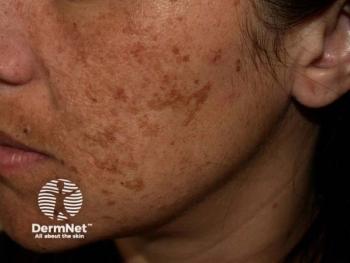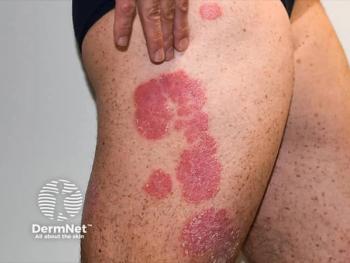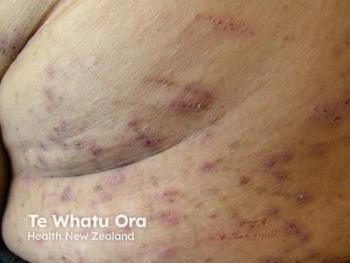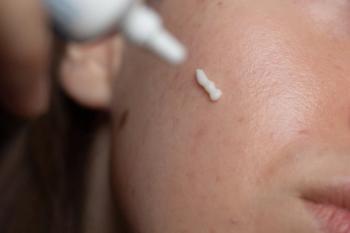
Upadacitinib Induces Long-Term Remission in Refractory Bullous Pemphigoid: A Case Report
Key Takeaways
- Upadacitinib, a JAK1-selective inhibitor, offers a targeted approach for refractory bullous pemphigoid by blocking Th2-mediated inflammation.
- The JAK/STAT pathway's involvement in BP pathogenesis supports the rationale for JAK1 inhibition, potentially offering a favorable safety profile.
Upadacitinib’s targeted inhibition of JAK1 offers a novel strategy for managing bullous pemphigoid and, in rare, treatment-resistant cases, may induce sustained remission following immune modulation.
Bullous pemphigoid (BP) is a chronic autoimmune blistering disease characterized by tense bullae, severe pruritus, and circulating autoantibodies against hemidesmosomal proteins. Standard first-line therapy includes systemic corticosteroids, often supplemented by doxycycline or steroid-sparing immunosuppressants such as azathioprine or mycophenolate mofetil.1,2 Despite these options, a significant proportion of patients experience relapses or fail to achieve adequate control, prompting the need for alternative therapies.
Upadacitinib (Rinvoq; AbbVie) is an oral JAK1-selective inhibitor currently approved for conditions such as rheumatoid arthritis and atopic dermatitis. Although not FDA approved for BP, emerging evidence suggests a role for JAK/STAT signaling in BP pathogenesis.3-5 Elevated levels of Th2 cytokines—including IL-4 and IL-13—activate this pathway, supporting a rationale for JAK1 inhibition in refractory cases.6,7 This case report illustrates successful remission of BP using upadacitinib after failure of conventional and biologic therapies.8
Case Presentation
A 72-year-old man presented with a blistering eruption involving the left hand and forearm. A lesional skin biopsy revealed subepidermal vesicular dermatitis with eosinophils and neutrophils. Although the histology was suggestive of BP, the diagnosis was confirmed via indirect immunofluorescence, which showed elevated BP180 immunoglobulin G antibodies (14.1 U/mL, reference < 9).
Initial treatment included systemic prednisone taper, doxycycline, and niacinamide. However, disease control remained elusive. The patient subsequently underwent 6-month trials of dupilumab and omalizumab—both without success. Although prednisone offered partial control, flares recurred with tapering. Given his refractory disease course, upadacitinib was initiated at 15 mg every other day.
Within 2 months, the patient experienced marked clinical improvement, with resolution of existing lesions and no new blister formation. After 6 months, upadacitinib was reduced to 7.5 mg every other day and eventually discontinued entirely after 1 year. The patient has remained in remission without any therapy for an additional 18 months.
Clinical Implications
This case highlights an emerging therapeutic strategy in dermatology: the off-label use of JAK inhibitors for autoimmune blistering diseases. Several important clinical considerations include the following:
- Refractory BP management: BP can be difficult to treat when conventional immunosuppressants and biologics fail. Upadacitinib offers a targeted approach by blocking cytokines involved in Th2-mediated inflammation.
- Mechanistic rationale: BP pathogenesis involves heightened expression of IL-4/IL-13 and JAK/STAT pathway activation.9,10 JAK1-selective inhibition could modulate this response with a potentially favorable safety profile compared with broader immunosuppression.
- Durable response: Remarkably, the patient not only achieved complete remission but also maintained it for more than 18 months after discontinuing therapy, raising the possibility that JAK inhibition may recalibrate long-term immune activity in BP.
- Literature support: This case joins only 2 prior reports describing BP improvement with upadacitinib, emphasizing the need for broader clinical investigation and controlled trials.6-8
Conclusion
This case report adds to the growing body of literature on JAK inhibitors in dermatology by documenting a rare instance of sustained remission of BP following upadacitinib therapy. Upadacitinib’s targeted inhibition of JAK1 offers a new therapeutic avenue for BP by blocking Th2-associated cytokines involved in disease pathogenesis and, in rare cases, may induce durable remission in otherwise refractory presentations. For patients with treatment-resistant disease, upadacitinib may represent a viable off-label option with durable benefits. Clinicians should remain aware of this emerging therapeutic avenue as the landscape of immune-modulating treatments continues to evolve.
Jennifer Fisher, MMSc, PA-C, is a board-certified dermatology physician assistant and medical writer in Connecticut.
References
- Bernard P, Antonicelli F. Bullous pemphigoid: a review of its diagnosis, associations and treatment. Am J Clin Dermatol. 2017;18(4):513-528.
- Borradori L, Van Beek N, Feliciani C, et al. Updated S2 K guidelines for the management of bullous pemphigoid initiated by the European Academy of Dermatology and Venereology (EADV). J Eur Acad Dermatol Venereol. 2022;36(10):1689-1704.
- Juczynska K, Wozniacka A, Waszczykowska E, et al. Expression of the JAK/STAT signaling pathway in bullous pemphigoid and dermatitis herpetiformis. Mediators Inflamm. 2017;2017:6716419.
- Zhao L, Wang Q, Liang G, et al. Evaluation of dupilumab in patients with bullous pemphigoid. JAMA Dermatol. 2023;159(9):953-960.
- Xiao Y, Xiang H, Li W. Concurrent bullous pemphigoid and plaque psoriasis successfully treated with janus kinase inhibitor baricitinib. Dermatol Ther. 2022;35(10):e15754.
- Nash D, Kirchhof MG. Bullous pemphigoid treated with janus kinase inhibitor upadacitinib. JAAD Case Rep. 2022;32:81-83.
- Gresham LM, Kirchhof MG. A case of drug-induced bullous pemphigoid secondary to immunotherapy treated with upadacitinib: a case report. SAGE Open Med Case Rep. 2023;11:2050313X231160926.
- Martin S, Burshtein J, Hoyer S. Remission of bullous pemphigoid in a patient treated with upadacitinib: a case report. J of Skin. 2025;9(3):2381-2384.
- Amara S, Sapoznik A, Guenin S, Kodali N, Lebwol M. Off-label uses of upadacitinib. SKIN J Cutaneous Med. 2024;8(4):1614-1643.
- Samuel C, Cornman H, Kambala A, Kwatra SG. A review on the safety of using JAK inhibitors in dermatology: clinical and laboratory monitoring. Dermatol Ther (Heidelb). 2023;13(3):729-749.
Newsletter
Like what you’re reading? Subscribe to Dermatology Times for weekly updates on therapies, innovations, and real-world practice tips.


















